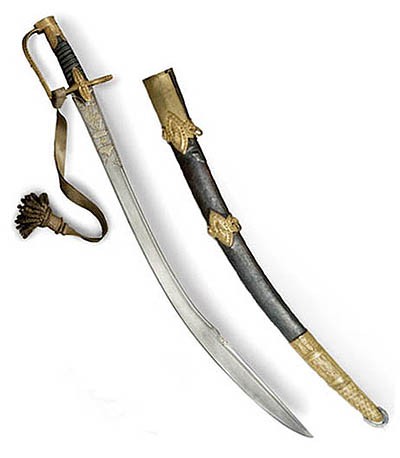With a “German-style” hilt and an “oriental-style” blade and scabbard, thus combing two fashions that were particularly popular at the start of the Consulate, this sword is unusual but nevertheless authentic. The hilt includes a simple gilded brass guard, the interior of which bears the inscription “Le 1er Consul au general Ney” (“The 1st Consul to General Ney”). The oval pommel is offset from the grip, particularly characteristic of a sword “à l'allemande”. The grip is wood, finished in dark sheepskin and decorated with silver filigree. The cross-guard features two rectangular, vertical quillons which bear an image of Jupiter's thunderbolts, devices that at the time signified command but would also shortly after become a symbol associated more specifically with the General Staff. The finely sculpted cross-guard is mounted on a beautiful oriental Pala blade made from Damascus steel with gold epigraphic decoration. Above the hilt is a design, engraved with a fragment from the Koran praising God, at the centre of which is a badge bearing the swordsmith's signature, “Moissa Farah”.
During the Egyptian campaign, it became the trend for French officers to adopt oriental side-arms. These swords were often “taken” from combat, such as with the famous Mamluk horsemen, or otherwise simply purchased in one of the many souqs in Cairo. These blades made it back from Egypt in baggage belonging to Republican officers, which explains how the Versailles arms manufactory was able to obtain a number of examples of these swords to use as models for their own limited-number luxury and ceremonial arms destined for important military figures.
The scabbard was specially made for this sword: the wooden splints are finished in shagreen and the three decorations in gilded brass. These latter, the chape, strap and locket, are embossed with decorative floral motifs. Finally, the throat bears the inscription “Manufacture de Versailles”. It is highly likely that this arm was offered to General Ney following the Battle of Hohenlinden on 3 December 1800 during which he acquitted himself with great bravery. The General was made a Maréchal of France on 19 May, 1804.
Christian Blondieau (tr. H.D.W.)
July 2009
Luxury sword given by the First Consul to General Ney
Artist(s) : VERSAILLES Manufacture de

- Date :
- 1801
- Technique :
- Steel, gilded brass, wood, tanned sheepskin, leather
- Dimensions :
- H = 96 cm
- Place held :
- Paris, Fondation Napoléon, inv. 1114 (Lapeyre donation)
- Photo credit :
- © Fondation Napoléon - Patrice Maurin-Berthier

